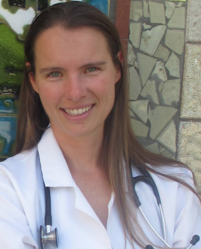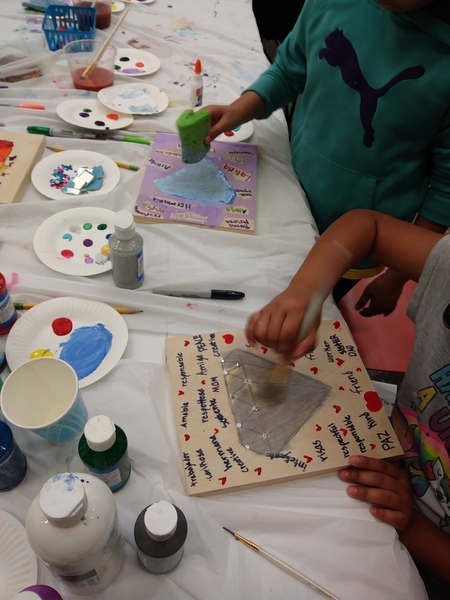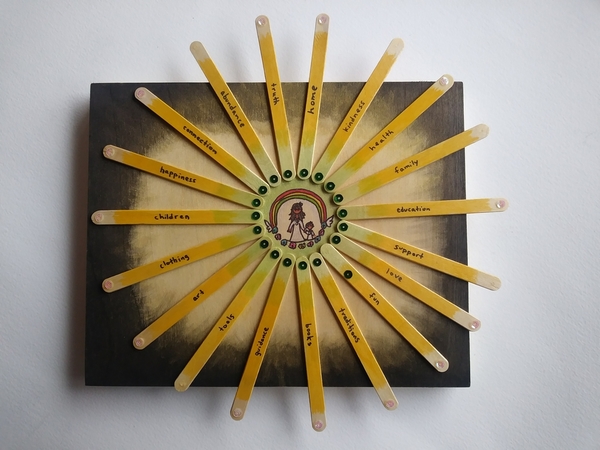Photo of art from class courtesy of Dr. Bymaster
Dr. Angela Bymaster, a family doctor in San Jose, Calif., was determined to find a way to teach ACEs science to her patients. Teens would come to the Washington Neighborhood Clinic clearly depressed by a range of problems at home that were contributing to risky sexual behavior and marijuana use, as well as preventable health problems like extreme obesity and polycystic ovarian syndrome. The clinic is part of a non-profit called the School Health Clinics of Santa Clara County,

And their parents, who are also Bymaster’s patients, had their own concerns: “A lot of parents were telling me ‘I’m really worried about my child,’ because they suspect or know that some of these behaviors are happening. They see that the person’s depressed and they want to help and they don’t know how,” she says.
Bymaster did some research and couldn't find educational materials that were suitable for her patients. So, she began reaching out to parents, students, community leaders and local academics for ideas and feedback. She wanted to develop a curriculum about ACEs, health and resilience that would resonate for the Latino immigrant families with first generation children, and for whom Catholicism is central.
ACEs refer to adverse childhood experiences and the CDC-Kaiser Permanente ACE Study, which links the toxic stress of childhood trauma with chronic disease, mental illness, substance use and being a victim of violence. The epidemiology of ACEs — along with the other parts of ACEs science that include how toxic stress damages young brains, its effect on short and long-term health, how it’s passed on from generation to generation, and how resilience research shows that brains and bodies can heal — is changing physicians’ approach to helping people heal and to stop passing ACEs from generation to generation.
“Because he’d seen a lot of the same things,” says Bymaster, one key source was a Honduran pastor of a Spanish-speaking neighborhood church who had been a psychologist in Honduras. He’d seen “a lot of domestic violence that’s not really talked about, a lot of unhealthy relationships between parents and kids and parents and parents, and kids and kids. And we talked about what would be topics that would be helpful to bring up in the curriculum.”
Bymaster also received a wealth of input from her teen patients and their parents; from Barbara Burns, a professor at Santa Clara University who leads a parenting class, and from Bymaster’s partners on the pilot, the San Jose Bridge program. The result was a five-week pilot that explores such topics as parents’ childhood stories; ACEs, resilience and health; negative interactions and how to flip them; the cultural differences between immigrant parents and their first-generation teens, and a session on forgiveness. After the first hour of each two-hour class, the 20 participants — 10 parents and 10 teens from the same neighborhood — participated in an art project led by Santa Clara County-based visual artist Elizabeth Jimenez Montelongo. Bymaster, who borrowed the idea from Burns, says it was a way to end the sessions with some levity and calm.

The first session, says Bymaster, allowed parents to reflect on what happened in their own childhoods, to talk about where they grew up and who raised them, and, based on the advice of her pastor friend, to explore what it meant to be a parent or a child.
“He said, ‘You know, in some places, you turn 12, you get your school certificate and they tell you to go get married and start a family,’” explains Bymaster. In that session, they also talked about what was difficult and what they were grateful for during their childhoods. They were encouraged to point to fitting adjectives that described their parents, such as absent, unpredictable, kind, loving, and encouraging.
By far, the most challenging session, says Bymaster, was the one that included ACEs. In it, she described what each ACE is from the original ACE Study. “A couple of people said that it was very, very painful. I don’t think it’s helpful to have them remember things from their past, but I also want them to know what ACEs are.” Those who wanted to were invited to count up their own ACEs.
“One lady was triggered and we talked to her and gave her a resource that she could go to for free,” says Bymaster. However, after they spoke, the woman said she had felt better, and ended up not seeking further help.
There was another pressing reason that Bymaster thought it was critical to talk about ACEs: ”Some people in my practice, I’m finding, are being told that ACEs are normal. I had one patient who had experienced sexual trauma and she said her mom said to her ‘All of us go through that. Just get over it! It’s a normal part of life.’ So, I tried to explain to her this is not normal as a child. We try to normalize everything that happens to us. But it’s not normal. Children are supposed to feel loved, they’re supposed to feel safe, have everything they need – food, clothing and warmth. They’re not supposed to go through abuse and neglect.” Reflecting on the reactions to the segment, Bymaster says, “It wasn’t very fun for them to go through, so I'm trying to figure out how to do that better.”
During the same session, Bymaster also described techniques that parents could use to build resilience and their relationships with the teens, including eating meals together, laughing together, looking each other in the eyes, and supporting each other when they’re going through difficulties. “All of those things could build positive relationships in the family and can break cycles of emotional abuse,” she says. And Bymaster invited participants to choose one positive action they’ll put into practice — such as telling their family member that they love them or forgiving them.
And part of the resilience-building segment also focused on other nuances that she said played out in the families she served, which one of her teen patients had confirmed was significant. Bymaster asked the student how often she had heard a parent apologize when they’ve made a mistake. “She said, ‘Well, that just never happens in my family and it would just mean so much to me if it did.’” Bymaster realized that It was an obvious choice to include in the curriculum, a simple way to build trust.
And because religion is so much a part of their lives, a lot of faith-based language filtered through the workshop. In the third session on human relationships, for example, the group was invited by Bymaster to talk about negative words that people have used when interacting with them. “We talked about how those weren’t God’s words, and using those words is a sin committed against you,” says Bymaster. In turn, they were guided to think of beautiful words to use with others and loved ones, and to have gratitude for the families that they have been fortunate to have.
The fourth session was an attempt to bridge the cultural divide between immigrant parents and their children raised in the United States. “It was about feeling empathy for the parent from the perspective of an adolescent and the other way around. ‘I understand why you want to be independent like your friends, but here’s why family is so important to me,’” she says, giving example of how participants were guided through an exercise in empathy.
The final class, later this week, will focus on the meaning of forgiveness, says Bymaster. “I’ve seen a lot of resentment that can hurt families.” To offer an antidote for them to consider, she explained, “I’ll ask them to think about someone they need to forgive or to forgive themselves.”
While the pilot included some uncomfortable discussions, says Bymaster, it has also had lighter moments: “We have been laughing a lot and the art was really lovely.”
The group will meet one more time for a potluck and celebration. Bymaster says she intends to fine-tune the curriculum with feedback from the group. She was hoping to hand it over to the San Jose Bridge program, but she may not be able to do that just yet.
“One of the moms has been chatting about [the group] with other people. Now they’re all mad that they’re not in the group,” laughs Bymaster. “So now I have to get another grant or raise some money. They were all like, ‘What is this group, Dr. Angie?!’”





Comments (0)